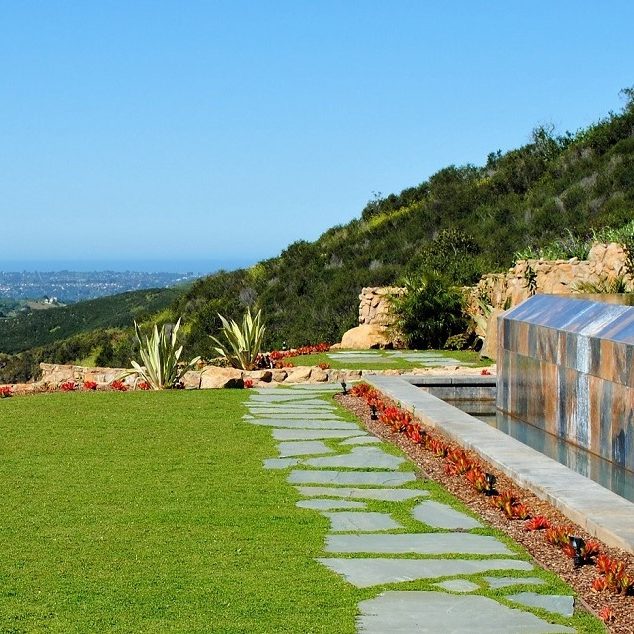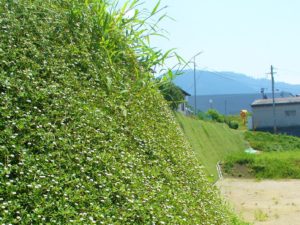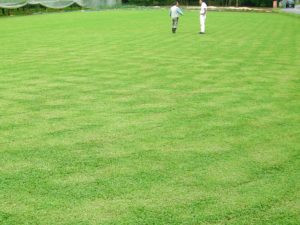
Kurapia – A Lawn Alternative
A traditional lawn is an outdated concept. Lawns are a design aesthetic that dates back to agriculture. In areas where rainfall was plentiful, the grass grew fast and long enough to feed livestock in areas known as commons. As farmers purchased and bred more and more animals, the pressure on the commons would end up in starvation for all the animals the foraging killed the grass. This was known as the ‘Tragedy of the Commons’.
But why are lawns still so important in our culture? Lawns symbolize wealth and power, they symbolize control over nature. Instead of a natural garden full of weeds and wildlife, a small patch of perfect green seemed to demonstrate an authority over nature.
Most Common Types of Grass in California
The three main grasses that people use in California are Fescue, St. Augustine, and Bermuda. The most common is Fescue. Of this, the brand “Marathon” is the most popular. Marathon bioengineered a lawn that could handle a lot of traffic and damage – so long as it’s regularly watered, mowed, and fertilized. And it’s a hungry plant, this variety of fescue, known as “Dwarf Tall Fescue”, is as moronic as oxymoronic, as it requires high nitrogen to stay green, and thus high water to keep from burning.
So how does Fescue lawns impact the environment? That large amount of nitrogen has to be delivered to the soil by either time release pellets or liquids. Since the root mass of the grass is only a few inches deep, at best, guess how much of that nitrogen gets carried through the groundwater, down our gutters, and into our oceans? Far too much. Clogging our waterways with stinking algae and killing our fish. One of the many reasons 90% of our seafood is imported.
How about St. Augustine? People flock to it since it grows thick and durable, with long heavy leaves that grows on long stolons “runners” that creep along the soil. The only problem is St. Augustine is a marsh plant. Marshes are known for having a large amount of organic material in the soil (known as muck) and is usually always wet. California soils, with the exception of a few streams and lakes in the lowlands, is quite the opposite. In order for St. Augustine to flourish we have to water constantly.
We have to keep adding things to the soil to keep it water retentive. In addition to leeching more nitrogen to the water, we’re also trying to create an entirely different ecosystem, and in doing so we place all the wildlife, surrounding waterways, and native plants in danger as the wrong type of bacteria, fungus, and other things grow. Not to mention gnats and other marsh plants. It goes dormant in the winter, so in colder areas you’re looking at a dead lawn for a few months.
Then there’s Bermuda grass. It’s the plant we use for putting greens because it can handle being cut the shortest. For a golf course to keep a putting green perfectly groomed it has to be grown in fine sand, cut with special mowers, and watered religiously. As a lawn, bermuda spreads by aggressive rhizomes.
These rhizomes will spout from the smallest piece of the plant, either runner or root. That means it can easily spread to the rest of your yard. In fact, gardeners who mow multiple lawns can pick up pieces of your neighbor’s bermuda in their mowers and deposit it into your lawn, which is why so many lawns end up looking like a mixture of various grasses after awhile. Bermuda grows like mad in the summer then goes dormant in the winter. Another culprit for “patchy” lawns in the winter.
What Are The Alternatives to Lawns?
Well there’s artificial grass. Have you seen this? It’s a lawn of plastic grass fibers woven into a little carpet. Up close they have the texture of a wire scrub brush, so it’s nothing you want to relax onto. Since it’s plastic, don’t walk on it on a hot day, because you’ll be walking right a bed of hot plastic. Ouch! From a distance it looks like a picture perfect lawn.. if the owner keeps it clean from debris, stains, and pet droppings. You’ll have to be raking, mowing, vacuuming, and even spraying weed killer on it when weeds pop up. Personally, when I think of a lawn, I think of something I can walk on barefoot on a hot day. This would be quite painful! Also… it’s highly flammable plastic, very unsafe to be around if there’s ever a fire.
Kurapia Drought Tolerant Lawn Alternative
Let’s take a look at Kurapia. You’ll find Kurapia will give you everything you want in a groundcover. It’ll stay low, be cool and comfortable to walk on. It will require little to no maintenance, and with a monthly mowing it will be like walking on a yoga mat. The whole family and your pets will get to know and enjoy this amazing lawn alternative.
We encourage you to read the Kurapia Support Documentation on our website, and read some of our Reviews for more information. You may complete the contact form on our website for more information or send us a note directly at info@kurapia.com.
Kurapia is only sold online and shipped directly to your home or business. We recommend planting Kurapia in US Department of Agriculture (USDA) Zones 7b or warmer.
Find your climate zone here.
Thank You!




